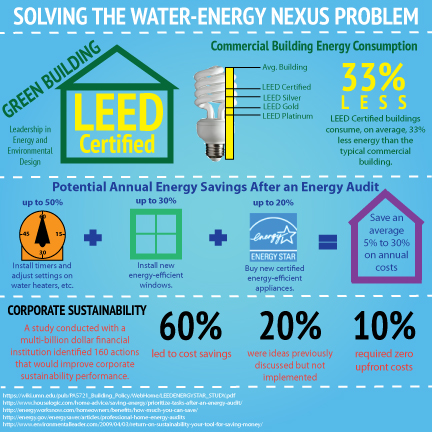No products in the cart.
Water-Energy Nexus Can Be Minimized With 3 Solutions
Water and energy are intertwined, which leads many to refer to them as the water-energy nexus. Energy production requires water, and supplying water to the general population requires energy. The conservation and proper management of these resources are imperative to maintaining a balance between energy demand and limited resources.
When tasked with finding a solution, one thing comes to mind: energy conservation. The key is to start changing the perception of “green” and “sustainability” by encouraging consumers to view these as strategies aimed at energy efficiency and cost savings.

How does one go about changing people’s perceptions when they have been taught for generations to think about energy the same way? Easy. Begin with setting guidelines. Establish regulations to dictate how every new project can approach sustainability, and educate the general population about the benefits they can reap from energy efficiency and sustainability.
1. Integrate green building strategies into minimum zoning requirements.
Green building techniques benefit the environment, the health of the building occupants, and the investment of the building’s owner. The Leadership in Energy and Environmental Design (LEED) rating system offers a comprehensive standard to guide building design and construction. One of the most important credit categories within LEED to help minimize the energy-water nexus problem is the Materials and Resources section. Specifically, the Building Reuse, Material Reuse, and Recycled Content categories would help balance water and energy use. Both Building and Material Reuse require the reuse of construction materials, thus keeping unnecessary trash out of the landfills and decreasing the demand for the purchase of new materials. This represents a cost savings for the project and a decrease in the amount of resources used for the production of new materials.
Teaching the general public about green building options is only part of the battle. We need people to begin implementing these strategies in their own lives. One way to inspire change is to offer financial incentives, such as tax breaks to LEED Certified buildings. These incentives, coupled with potentially lower operating costs, make up for the extra costs associated with sustainable design. Save money and help the environment; it’s a win-win situation. A “no-brainer.”
2. Conduct energy efficiency audits on existing buildings to determine ideal retrofitting recommendations.
The easiest way to help minimize the energy-water nexus problem is to optimize the performance of residential and commercial buildings.
An energy auditor evaluates the building as a whole, takes into account how all systems interact, and provides a room-by-room assessment of a building’s energy use in order to make recommendations for improvement. Retrofitting a building for energy efficiency can provide a 5% to 30% savings on energy bills and reduce its overall energy use.
3. Implement sustainable practices in business models.
The novel idea of corporate sustainability stems from a business need to establish cost efficient practices that complement social responsibility. Recently, a U.S.-based organization launched the Sustainability Accounting Standards Board (SASB) to push businesses to strive for sustainable practices and hold them accountable.
SASB will provide sustainability reports from publicly traded companies to investors. In the near future, this will help investors make smart business decisions by highlighting the companies that are committed to optimizing processes and reducing environmental impact. Corporate sustainability is a key component to changing the general population’s perception of energy use.
Implementing these three concepts into everyday practice will significantly help the water-energy nexus problem and highlight the need to plan for the future now. The earth’s precious resources are quickly decreasing, and it is imperative to start drafting regulations that encourage sustainable practices and promote environmentally friendly agendas.
This post is participating in the Engage: The Water-Energy Nexus Blogging Contest hosted by Masdar in honor of the Abu Dhabi Sustainability week.